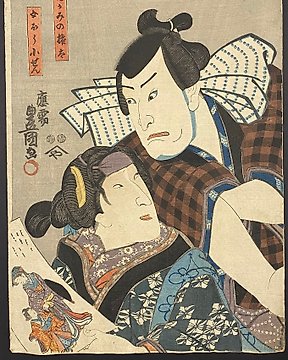
Actors Nakamura Utaemon IV as Igami no Gonta and Bandô Shûka I as His Wife Kosen - 1848 - Utagawa Kunisada (1785-1865) - Japan - Edo-perioden (1600-1868)
Nr. 81878411

Nr. 81878411

Original woodblock print - Paper - Utagawa Kuniyoshi (1797-1861) - “Soga kyōdai chichi no adauchi-zu” 曽我兄弟父の仇討図 (Soga Brothers take Father's Revenge) - Japan - 1851 (Kaei 4)
The signature is ‘ Ichiyuusai Kuniyoshi-ga‘ 一勇斎国芳画
Reasonable condition, stains, rubbing, holes
See British Museum: https://www.britishmuseum.org/collection/object/A_2008-3037-19003
Kuniyoshi was one of the pupils of Toyokuni and was a late bloomer than Kunisada and other pupils.
Around the Bunsei-period, he published “108 Heroes of the Popular Suikoden”, and it created a sensation and it made him popular. He was called “Warrior-painter-Kuniyoshi”, and he became one of the most popular Ukiyo-e artists.
Since then, he had created various attractive artworks that excelled in high drawing techniques, fascinated composition sense, and fantastic ideas and characters, without sticking to the framework of the Ukiyo-e.
The son of silk dyer, little is known about Ukiyo-e artist Utagawa Kuniyoshi’s early years, though he is said to have shown remarkable talent from a young age. At age 14 he was accepted to study woodblock printing under Utagawa Toyokuni I and would become one of his most successful students. In direct contrast to Hiroshige and Hokusai’s peaceful views of a scenic Japan published in the 1830s and ‘40s, the following decades saw a rise in popular taste for the fierce, fearsome and fantastical in ukiyo-e, which Kuniyoshi embraced. In 1814, he left Toyokuni’s studio to pursue a career as an independent artist. Initially, he had little success, selling tatami mats in order to support himself. His fortunes changed in 1827 with his dramatic series 108 Heroes of the Suikoden, and from that point on, he became known for portrayals of famous samurai and legendary heroes. Kuniyoshi also worked in in other print genres, producing landscapes and bijin-ga (pictures of beautiful women).
Hvordan kjøpe på Catawiki
1. Oppdag noe spesielt
2. Legg inn det høyeste budet
3. Å gjøre en sikker betaling